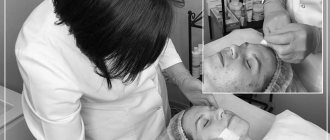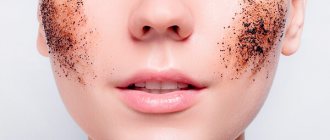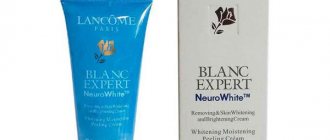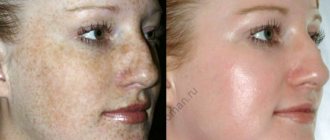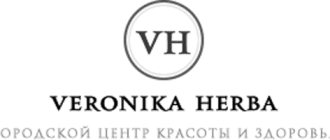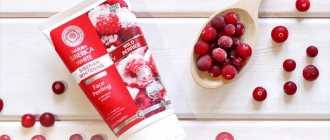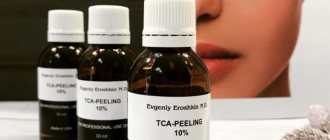Various acids in cosmetics are no longer news, but it still sounds a little scary, especially if you associate acid with chemistry lessons at school. There, during laboratory work, you could see how a whole piece of metal disappears in a small test tube. Don't be afraid, because acids in facial cosmetics are completely different. They are not just safe for our health, but even beneficial for the skin.
When we talk about acids in cosmetics, we mean exfoliation of dead skin cells. Deep peeling, in other words. The advantage of acids is not only this: in addition to the above, acids prevent moisture from evaporating from skin cells, i.e. help maintain skin elasticity and youth. The most famous of the “useful” acids is hyaluronic acid. She is a shining example of not so much exfoliation as nourishment and rejuvenation of facial skin.
Use of acids in cosmetics: why scrub the skin?
We don’t notice it, but our cells constantly live and die, several million per day. These very approximate figures may vary depending on weather and other environmental conditions, as well as diseases and genetic inheritance. If you don't touch the skin in any way, a lot of dead cells will accumulate. This leads to several unpleasant consequences:
- Early appearance of facial wrinkles or deepening of existing ones;
- Dullness and uneven complexion;
- Peeling of the skin, enlargement and clogging of pores.
These and other troubles can be easily eliminated by regular exfoliation of the skin in two ways:
- Mechanical peeling. The essence is to remove the topmost layer of skin, that is, dead cells. This is done with the help of abrasive particles; they can be found in some cosmetics: scrubs, peelings and others;
- Chemical peeling. It works a little differently - due to the presence of various acids in the composition. Like abrasive particles, acids remove the stratum corneum and improve the condition of the skin in general. This kind of cleansing allows nourishing cosmetics to work more effectively and penetrate deeper into the layers of the skin.
Modern dermatologists are increasingly turning to the second option, because it is less traumatic for the skin. In mechanical peeling products, exfoliating particles can be harsh and irritate the skin. Brushes and scrubs cannot give a long-lasting and strong effect, since they act on the very top layer of the skin without penetrating deep. The use of acids in cosmetics, on the contrary, allows the procedure to be considered therapeutic and can have a much more effective effect on the skin. This works by reducing the activity of the sebaceous sweat glands, as well as eliminating hyperpigmentation, post-acne and signs of photoaging, tightening pores, deeply nourishing and moisturizing the skin.
Vichy, Normaderm
Where to buy: vichyconsult.ru - 1,771 rubles, wildberries.ru - 1,328 rubles.
A very light cream with a gel texture. You can use it from the age of 30, it works great with the first wrinkles, improves complexion and reduces the production of sebum, which means it fights pimples. The main thing is not to skimp, because its consistency allows you to distribute a small amount over your face, but we need a dose approximately the size of a bean.
What problems can acids in cosmetics solve?
Acids of various types and stripes are similar in one thing - the principle of operation, namely in the dissolution of dead skin cells. This process frees up space for new cells to appear and reduces the number of dead cells in the future. In simple terms, you purposefully and carefully damage the skin to make the texture smoother and renew the cells. As a bonus, you will make it easier for moisturizing and nourishing products to work - after acid peeling, it will be much easier for the main components to penetrate into the deeper layers of the skin and work easier. In modern cosmetology, several categories of acids are used.
Home Recipes
Certain types of creams can be purchased at the pharmacy and you can prepare an effective skin care cream yourself at home. Popular homemade recipes are discussed in more detail below.
Orotic acid cream
To prepare the cream, mix 30 ml of almond oil and 10 ml of sucrose stearate, and then heat in a water bath for 10 minutes with the addition of 80 ml of basil decoction. Orotic acid (5 tablets) is crushed into powder and added to the prepared mixture. After the product thickens a little, add 5-6 drops of grapefruit essential oil.
Salicylic acid cream
The recipe for making a fairly simple wax in the amount of 10 grams is melted in a water bath and 10 ml of salicylic acid and rice oil are added. The finished cream is used after complete hardening.
Cream with ascorbic acid
To prepare, mix 50 ml of coconut oil with 100 ml of olive oil with the addition of 10 ml of lanolin and wax. The finished mixture is heated in the microwave for 40 seconds, and then 100 ml of non-carbonated mineral water and 50 ml of freshly squeezed aloe juice are added. 8 crushed tablets of ascorbic acid are mixed into the cream and seasoned with patchouli ether (a few drops).
Cream with hyaluronic acid
The cream is made by mixing the same amount (10 ml) of olive, linseed, sunflower oils and heated until warm in a water bath. Borax (10 ml) is dissolved in 50 ml of non-carbonated mineral water. The mixture is cooled and seasoned with esters (2 drops) of lavender or ylang-ylang. Hyaluronic acid (10 mg), previously diluted with a small amount of water, is added to the finished cream.
AHA acids in cosmetics
They are obtained from milk and various plants, but most of what we see in cosmetics is artificially created in laboratories. If the concentration of alpha acids is low, they can retain moisture inside skin cells (up to 4%). If more (from 5%), it works like a scrub - exfoliates dead cells.
AHA acids dissolve in water and cannot penetrate deep into the layers of the epidermis. But they work great on the surface itself:
- Exfoliate;
- Remove signs of aging: wrinkles, lack of firmness, radiance, elasticity, etc.;
- Remove hyperpigmentation;
- Fighting post-acne;
- They help collagen and elastin to be produced in the right quantities.
The most popular in this category is glycolic acid, it has been studied from all sides to find out its pros and cons. It is extracted from red cane and is considered the cheapest and most effective. It is also believed that extremely high concentrations of glycolic acid (found only in salon treatments) are very useful in treating advanced stages of acne. In addition, it helps increase collagen production and moisturizes the skin well.
Citric acid in cosmetics often acts not as an active component, but as a preservative or regulator of the acidity of the product. However, in terms of effectiveness and beneficial properties, it is very similar to glycolic. Mandelic acid is difficult to find in cosmetics, as it does not work as effectively and exfoliates less effectively. But mandelic acid is great for people with sensitive skin.
Kinds
AHA acids are as follows:
- Glycolic acid is effective in treating hyperpigmentation. Contained in green grapes and sugar cane.
- Citric acid – has a whitening effect, removes toxins, is responsible for cell renewal, and promotes collagen production. Contained in lemon, kiwi, lime, papaya, grapefruit, pineapple, orange.
- Lactic acid is responsible for moisturizing the skin and has an exfoliating effect. Contained in sour milk, grapes, yogurt, tomato juice, blueberries, apples, maple syrup.
- Tartaric acid – another name is tartaric acid. Exfoliates, moisturizes and whitens the skin. Included in ripe grapes, oranges, and wine.
- Malic acid – promotes cellular metabolism, exfoliates. It is found in large quantities in tomatoes and apples.
The use of BHA acids in cosmetics
This group of acids, unlike the previous one, is soluble in fat. This quality allows them to penetrate much deeper into the layers of the skin and cleanse the pores from the inside. They effectively fight acne, acne and act as a preventive measure. The most famous acid in this category is salicylic acid, although it differs in composition from others. As a mono product it has disinfecting and anti-inflammatory properties. Recommended for people with oily skin types prone to inflammation and acne. Like AHA acids, salicylic acid perfectly fights photoaging, hyperpigmentation and perfectly exfoliates the skin.
Caudalie, Vinoperfect
Where to buy: iledebeaute.ru - 2,528 rubles, market.yandex.ru - 2,528 rubles.
This cream is a true night sniper that targets wrinkles, dullness and pigmentation while you sleep. It is also a gentle and delicate product that is suitable even for those with sensitive skin. Moreover, it can be applied in a thick layer, like a mask, and left overnight. The result will surprise you!
And here you will find real masks that work well: Secrets of Korean women: face masks up to 300 rubles.
How to choose facial cosmetics with acids
Which product with acid in its composition you should choose depends on your goals and needs: get rid of acne, remove wrinkles, exfoliate the skin, and so on. If treatment and deep effects are not required, AHA acids are suitable. They will cope with photoaging, hyperpigmentation, dullness and exfoliation. Pay attention to the acid concentration in the cosmetic product. ANA acids should not be more than 10% (ideally 5-8%).
If your problems are acne, large clogged pores, etc., then BHA acids are suitable for you. For example, salicylic acid will help regulate the functioning of the sebaceous glands and relieve inflammation. Acid alone will not be able to cure acne, but it will greatly help special cosmetics penetrate deeper into the layers of the skin and work more efficiently. The optimal concentration of BHA acids in cosmetics is 1-2%.
Some cosmetics contain several acids from different groups. Multiple acids can work together and will not interfere with each other. However, the presence of more than one acid in the composition increases the risk of allergic reactions. One acid from any group is enough to exfoliate the skin and perform other tasks necessary for it. If the skin suffers from constant dehydration, then a combination of acids from different categories is quite possible: AHA can prevent moisture loss in skin cells, and BHA will disinfect.
Noreva
Exfoliac line (acids)
Important! Merck's Exfoliac brand was acquired by Noreva Laboratories. Noreva continues to produce Exfoliak without changing the composition or name of the series. Only the packaging changes (instead of the Merck logo there will be a Noreva logo).
Exfoliating gel (Facial Scrub)
Main characters. 10.2% glycolic acid. pH 3.5.
Full composition. Aqua, Polyethylene, Glycolic Acid, Ammonium Lactate, Glycerin, PEG-40 Hydrogenated Castor Oil, Xanthan Gum, Polysorbate 20, Menthyl Lactate, Tetrasodium EDTA, Cl 42090, Sodium Bicarbonate, Tocopherol, Methyldibromo Glutaronitrile, Phenoxyethanol, Parfum (Fragrance), Limonene , Alpha-Isomethyl Ionone, Butylphenyl Methylpropional, Benzyl Alcohol.
Volume. 50 ml.
Average price. 1000 rub.
Read more.
Deep Cleansing Mask
Main characters. Salicylic acid ester, lactic acid.
Full composition. Aqua, Kaolin, Tridecyl Salicylate, Glycerin, Cetearyl Alcohol, Pentaerythrityk Distearate, Butylene Glycol, Octyldodecanol, C20-22 Alkyl Phosphate, C20-22 Alcohols, Sorbitol, Magnesium Aluminum Silicate, Nelumbium Speciosum Extract (Nelumbo Nucifera Flower Water), Sesamum Indicum ( Sesame) Seed Extract, Serenoa Serrulata (Fruit) Extract, Argania Spinosa (Kernel) oil, Parfum (Fragrance), Sodium Hydroxymethylglyconate, Lactic Acid, Beta Sitosterol, Phenoxyethanol, Xanthan Gum, Sodium Hydroxide, Disodium DTA, Tocopherol.
Volume. 50 ml.
Average price. 1000 rub.
Read more.
Lotion (Exfoliac Lotion)
Main characters. 12.25% glycolic acid, 1% salicylic acid derivative, zinc, alcohol. pH 3.
Full composition. Aqua, Alcohol, Glycolic Acid, Ammonium Lactate, Isoceteth-20, Glycerin, Silanediol Salicylate, Bisabolol, Zinc PCA, Parfum, Disodium EDTA.
Volume. 125 ml.
Average price. 1000 rub.
Read more.
Acnomega 100 (Acnomega 100)
Main characters. 6% glycolic acid, 1.3% acid esters, 0.5% zinc, retinol palmitate. pH 3.5.
Full composition. Aqua, Tri-C12-C13 Alkyl Citrate, Glycolic Acid, Cetearyl ISonanoate, Cyclopentasiloxane, Butylene Glycol, PolyMethyl MethachacryLate, Hydroxypropropyl Starch Phosphate, Blood Ycerin, Glyceryl Stearate, PEG-100 Stearate, Sodium Hydroxide, Cetyl Alcohol, Propylene Glycol Alginate, Methyl Glucose Sesquistearate, Cetearyl Alcohol, Ceteareth-20, Stearyl Glycyrrhetinate, Butylene Glycol, Alcohol, Pentylene Glycol, Caprylyl Glycol, Polyglyceryl-10 Laurate, Cocamidopropyl PG-Dimonium Chloride Phosphate, Disodium EDTA, Zinc Gluconate, Xanthan Gum, Bisabolol, Disodium Lauriminodiprop ionate Tocopheryl Phosphates , 10-Hydroxydecanoic Acid, Sebacic Acid, 1,10-Decanediol, Retinyl Palmitate, Helianthus Annuus Seed Oil, Tocopherol, Parfum (Fragrance).
Volume. 30 ml.
Average price. 800 rub.
Read more.
Acnomega 200 (Acnomega 200)
Main characters. 9.88% glycolic acid, lactic acid, 2.5% salicylic acid, 2.42% acid esters, retinol palmitate. pH 3.5.
Full composition. Aqua, TRI-C12-C13 Alkyl Citrate, DI-C12-C13 Alkyl Malate, Glycerin, Glycolic Acid, Lactic Acid, Polymethyl Methacrylate, Cyclopentasiloxane, Butylene Glycol, Sodium Hydroxide, Hydroxypropyl Starch Phosphate, Glyceryl Stearate, PEG-100 Stearate, Bisabolol , Propylene Glycol Alginate, Methyl Glucose Sesquistearate, Cetyl Alcohol, Cetearyl Alcohol, Ceteareth-20, Stearyl Glycyrrhetinate, Alcohol, Pentylene Glycol, Caprylyl Glycol, Polyglyceryl-10 Laurate, Cocamidopropyl PG-Dimonium Chloride Phosphate, Disodium EDTA, Zinc Gluconate , Xanthan Gum , Disodium Lauriminodipropionate Tocopheryl Phosphates, 10-Hydroxydecanoic Acid, Sebacic Acid, 1,10-Decanediol, Salicylic Acid, Cocamidopopyl Dimethylamine, Glyceryl Stearate, Zea Mays Starch, Hydrolyzed Corn Starch, Hydrolyzed Starch Octenylsuccinate, Retinyl Palmitate, Helianthus Annuus Seed Oil, Tocopherol , Parfum (Fragrance).
Volume. 30 ml.
Average price. 1000 rub.
Read more.
Global 6 cream (Global 6 Corrective and Unclogging Imperfections Care)
Main characters. 6% encapsulated 2% salicylic acid.
Full composition. Aqua (Water), Isoamyl Cocoate, Silica, Hydrolyzed Corn Starch, Steareth-2, Steareth-21, Salicylic Acid, Cetearyl Alcohol, Cocamidopropyl Dimethylamine, Bakuchiol, Dimethicone, Hydroxypropyl Starch Posphate, Hydroxyehtylcellulose, Parfum (Fragrance), Benzyl Alcohol, Sodium Hydroxide, Xanthan Gum, Chlorphenesin, Disoidum Edta, Hydrolyzed Hyaluronic Acid, Butylene Glycol, Polyquaternium-67, Hydrated Silica, Hexyl Cinnamal, Linalool, Butylphenyl, Methylpropional, Glycerin, Sorbic Acid, Benzly Salicylate, Citronellol, Alpha-Isomethyl Ionone, 10- Hydroxydecanoic Acid, Sebacid Acid 1,10-Decanediol, Eugenol.
Volume. 30 ml.
Average price. 1000 rub.
Read more.
How to care for facial skin with acids
The following are not strict rules, but recommendations. They are worth knowing and considering before using mono-acids or cosmetics with acids. What you need to know:
- Acid needs to spend some time on the skin to work properly. What does this mean: “washes” will be useless, since they are on the surface of the epidermis for a very short time. Pay attention to tonics, serums, creams and other similar products. The latter will spend much more time on the skin and the acid will have time to work as it should;
- You should not apply all products with acids on yourself at once. This will only provoke an allergic reaction, or, at best, increase the sensitivity of the skin. If you have a gentle product, use it every day. It is better to apply a strong one to the skin once a week, or even two. Let's say you have a facial tonic with a mild acid in its composition - use it daily (preferably once a day). It is better to use an acid mask once a week, and the next day do not touch your face with anything. This way you will give your skin a little rest and recovery, and protect yourself from various types of allergies and irritations;
- If you are just getting acquainted with acids, start small: use cosmetics with acids once a week, then two, three, and so on. Don't forget the point above and remember that it all depends on your skin's needs. If you find that you only need a weak acid toner once a week, don't use it more often or add stress to your skin with anything else;
- If you have several acid products with different groups in the composition (for example, AHA and BHA), use these products on different days. You should not combine the use of all the remedies in one day, as you will do more harm than help;
- If you have sensitive skin areas, avoid them. Acids can only make the situation worse;
- Keep the product exactly as long as it is written in the instructions. You shouldn’t leave cosmetics on your face too long in hopes of the best - this is another way to increase sensitivity and lead to allergies;
- Test everything for allergies on the crook of your elbow before applying to your face. If you feel a slight tingling or see slight redness, this is normal. If the area where the acid was applied burns strongly, the skin is red and itchy, wash it off immediately. Don't be patient and wait for it to pass. There are three possible options: either the product is not suitable for you, or you applied too much, or left it on longer than expected. In any case, it's not worth the risk - this is no joke;
- In the sunny season, be very careful - acids increase the skin's sensitivity to ultraviolet radiation and can cause hyperpigmentation and scarring. Here's how it works: that same keratinized layer of cells acts as a kind of filter for the sun's rays, and acids remove it. There is no filter - there is nothing to protect the skin;
- To save yourself from troubles in the summer, always apply special sunscreen cosmetics before going outside. Cosmetics with SPF protect the skin from the harmful effects of the sun. It is best to protect yourself from the sun's rays all year round, even in winter. Even the weakest sun can damage the skin and cause photoaging.
Acids in cosmetics are necessary to help our skin be healthy, beautiful and radiant. Pay attention to your face: what exactly do you need? Based on your needs and requirements, you can choose suitable cosmetics. Use them correctly, following the recommendations, and there will be nothing to be afraid of.
Care for oily and problematic skin
Oily skin is an inevitable consequence of increased activity of the sebaceous glands. Increased sebum secretion is most often due to the constitutional characteristics of the skin, but can be a consequence of hormonal imbalance, for example, during puberty or during pregnancy; provoked by neuropsychiatric disorders (schizophrenia, manic-depressive psychosis, post-encephalic and post-stroke syndrome); some endocrine diseases, pathology of the gastrointestinal tract, inadequate cosmetic skin care.
Oily and problem skin occurs in women and men, more often in young people. A grayish tint to the skin, a pronounced oily sheen, a rough pattern, a rough surface, large pores, acne - this is not a complete list of depressing symptoms characteristic of oily skin. And if in winter, when the central heating is turned on, oily skin becomes somewhat drier, then in summer all problems worsen.
Oily skin requires constant special care. However, excessive enthusiasm can provoke an increase in the secretory activity of the sebaceous glands, while the surface layers of the skin may become dry and dehydrated. In this regard, the main concept of care is “Problem skin - gentle care”, while simultaneously influencing all factors in the pathogenesis of problematic oily skin.
In the development of seborrhea and the most common complication that occurs against its background, acne, several pathogenetic factors are identified:
- hyperproduction of sebaceous gland secretions;
- follicular hyperkeratosis;
- bacterial activity;
- inflammation.
An increase in the amount of sebum is accompanied by its qualitative changes. These changes primarily affect the concentration of linoleic acid, an unsaturated fatty acid that is an essential building block of any cell membrane. A decrease in the concentration of linoleic acid leads to a decrease in the pH of sebum, a change in the permeability of the follicular epithelium and a disruption of the barrier function of the epithelium. Favorable conditions are created for the growth of microorganisms on the surface of the skin and inside the follicles. These are primarily Propionibacterium acnes, fungi of the genus Pytirosporum and Staphylococcus epidermitis. During their life, these microorganisms utilize sebum using various lipases, which leads to an increase in the concentration of free fatty acids in the sebum and a decrease in the bactericidal and fungicidal properties of the skin.
Disruption of the keratinization processes in the upper part of the hair follicle leads to the accumulation of sebaceous gland secretions in the hair follicle and the formation of first microcomedones, and then closed and open comedones. In comedonal conditions, microorganisms actively multiply, as a result of which inflammatory mediators are released and inflammatory elements appear in the dermis.
Care for oily skin thus consists of high-quality cleansing, reducing microbial contamination, reducing sebaceous secretion, eliminating hyperkeratosis, improving appearance (masking skin defects), protecting from the sun and other sources of ultraviolet radiation, moisturizing and absorbing sebum.
Cleansing should be done gently and delicately, no matter how rough and greasy the skin may be. Among the products that carefully cleanse oily skin prone to acne formation are soaps, foams, emulsions, gels, milks, lotions, and tonics. When washing your face, it is always better to use warm or room temperature water, do not rub the skin with your hands or a sponge, and be sure to rinse off the detergent well. Cleansers should have a neutral or acidic pH, since changing the pH to alkaline is a good condition for P. acnes colonization. It's best to avoid bar soaps, which are more drying to the skin because they contain harsher ingredients. It is preferable to use syndet soap - the so-called “soap-free soap” with a pH of 5.5–7.0. For these purposes, Exfoliac is offered - a cleansing foaming gel containing ammonium lactate, which has a keratoregulating effect; zinc lactate, which reduces sebum secretion; a combination of soft surfactants (surfactants) that qualitatively cleanse the skin, do not disturb the hydrolipid film and do not cause reactive hyperseborrhea.
You need to wash your face 1-2 times a day. The choice of cleansers depends on the individual sensitivity of the patient's skin. In some people, frequent washing with soaps and gels causes the appearance of erythematous-squamous rashes and a decrease in the barrier properties of the skin. They can recommend the new Exfoliac skin cleanser, a micellar cleansing water that can also be used to remove makeup. Micellar cleansing water gently cleanses the skin, does not contain alcohol, soap or dyes. A composition of water and soft surfactants forms microspheres, invisible to the naked eye, which are capable of removing impurities and makeup residues mixed with sebum from the surface of the skin, without requiring rinsing with water. Micellar water is also used twice a day: in the morning - to cleanse the skin and prepare it for the application of therapeutic products or additional care products, and in the evening - to remove makeup, improve skin health, remove excess sebum and sweat.
After thorough cleansing, it is advisable to use exfoliating products 2-3 times a week. Exfoliation is a procedure for removing horny scales, which in oily skin do not exfoliate on their own. The purpose of this procedure is to smooth the surface of the skin, improve its texture and color, free the mouths of the pilosebaceous follicles from substances accumulated there and thus ensure a freer outflow of sebum. For the purpose of exfoliation, mechanical and chemical methods (scrubs, creams, masks) are used. Scrubs contain abrasive substances. To prevent the action from being too rough and damaging the skin, it is not recommended to rub it too hard. Exfoliant creams, which may include small concentrations (1–2%) of alpha, beta and polyhydroxy acids, are more gentle on the skin. For example, Exfoliac exfoliating gel contains free alpha hydroxy acids (AHAs) (glycolic acid), which have a chemical exfoliating effect; neutralized ANA (ammonium lactate), which has a moisturizing and keratoregulating effect, polyethylene particles that gently exfoliate horny cells without the risk of irritation. In addition, the exfoliating gel contains glycerol for hydration. For more effective skin cleansing - synthetic detergents.
It is recommended to use this exfoliant no more than 2-3 times a week, since exfoliation of the skin should not be overused. The thickness of the stratum corneum is limited, and after its removal, further attempts at exfoliation lead to damage to the stratum corneum. The skin becomes easily wounded, hyperemic, irritated, with increased sensitivity.
Unfortunately, both patients and some cosmetologists still practice classic traumatic cleansing with squeezing and coagulation, which in most cases not only does not lead to a lasting positive result, but also leads to the formation of iatrogenic skin defects. Frequent intense squeezing, especially with the use of a metal spoon, causes premature aging of the skin, and after coagulation scars of varying severity remain. When trying to cleanse the skin of pustules, there is always a risk of microorganisms disseminating over the entire surface and the appearance of many additional pustules.
A tonic lotion or freshener is selected in accordance with the severity of acne and the intensity of sebum secretion. With moderate hypersecretion, thick sebaceous secretion and the absence or small amount of inflammatory elements, it is advisable to use non-alcoholic lotions with the addition of aloe extract, chamomile, gammomelis, calendula, menthol and eucalyptus oils, which improves microcirculation, reduces inflammation and skin irritation. A good effect is also observed when using lotions containing AHA, as they have a keratoregulating and moisturizing effect.
For example, Exfoliac lotion contains AHAs and beta hydroxy acids (BHAs) (glycolic, lactic and salicylic acids), zinc pyrrolidone, which has a sebum-regulating effect, and bisabolol as an anti-inflammatory and soothing agent. The drug is intended for use on large areas: face, chest, back; effective for comedones and pustules. In cases of severe hypersecretion and the presence of acne, preference is given to drugs with antimicrobial effects. In this case, the drug is applied locally. Exfoliac NC-Gel contains niacinamide or nicotinamide (a derivative of vitamin B3), which has anti-inflammatory, antihistamine and antiradical effects; ethyl alcohol, aluminum and magnesium silicate to give a matting effect. The gel is applied morning and evening to the inflamed areas.
Moisturizers are an important component of any skin care. The most popular way to hydrate is to use moisturizers. If the fat content is high, it is better to do without cream altogether, replacing it with tonic, gel, serum or milk. If a cream is still used, it should not be in the form of a greasy cream or ointment, and should not contain comedogenic compounds that impede the outflow of sebum. Typically, these requirements are taken into account by manufacturers of professional cosmetics. The choice of cream must be approached individually, taking into account the characteristics of the skin, the treatment being performed, the time of year, etc.
For oily, acne-prone skin, it is not recommended to use film-forming occlusive moisturizers. It is preferable to use products containing natural humectant factor (NHF) in combination with anti-inflammatory and nourishing ingredients, such as Exfoliac revitalizing moisturizer. It contains ceramides, which restore the skin barrier; triglycerides - compensate for the damaged hydrolipid film; alpha-bisabolol has a calming effect; glycerin - moisturizing. This cream can be used for severe skin dehydration, in particular after treatment with Roaccutane.
Patients with oily skin prone to acne need to remember that it is impossible to cure seborrhea and acne once and for all, but they can be kept under control. For this purpose, it is necessary to use pathogenetic cosmetics during care.
The main active substances contained in them can be divided into several groups according to their mechanism of action:
- Seboregulators: retinoids (retinol, retinaldehyde, 18-beta-glyceric acid in combination with zinc, etc.), 5-alpha reductase blockers (extracts of sabal and saw palmetto, fireweed, pumpkin, green tea, zinc, gamma-linolenic and linoleic acid, azenoloic acid, etc.), plant extracts (burdock, cedar, fir, cornflower, etc.).
- Regulators of proliferation and differentiation: nordihydroguaiaretic acid, retinoids, lipolic and linolenic acids, borage oil, avocado, phosphatidylcholine, etc.
- Anti-inflammatory: linoleic and gamma-linolenic acids, nordihydroguaiaretic acid, plant extracts (black poplar, witch hazel, aloe vera, chamomile, calendula, tea tree leaves, sage, linden, alfalfa, tricolor violet, etc.), allantoin, bisabolol, panthenol, 5-alpha reductase blockers, azelaic acid and antibacterial substances (indirectly).
- Antibacterial, antimycotic: triclosan, triclocarban, miramistin, sulfur, plant extracts (calendula, chamomile, burdock, cedar, fir, rosemary, green tea, kiwi, orange, juniper, spruce needles, etc.), piroctone olamine, tea tree essential oils , cloves, lemon, bergamot, cedar.
- Keratolytic: alpha and beta hydroxy acids, a combination of alpha hydroxy acids with amino acids, retinoids, azeloic acid, bodyaga, sulfur, enzymes (papain, bromelain, etc.).
- Matting agents (fat sorbents): silicon, aluminum and calcium silicates, polymer granules, clay, etc.
Most creams intended for the care of oily skin are multifunctional and contain a combination of active substances with a different spectrum of pathogenetic action.
For example, Acnomega 100 and Acnomega 200 creams contain an original keratoactive complex consisting of alpha, beta and omega hydroxy acids, zinc gluconate and bisabolol. These creams have a keratoregulating, anti-inflammatory, sebum-regulating, mattifying and pigment-constricting effect and are intended for the care of skin with mild to moderate acne. Due to the lack of photosensitizing effects of the drugs, they can be used in the summer, unlike some other cosmetics containing, for example, retinoids. In addition, which is very important, they do not have a teratogenic effect and are not contraindicated for pregnant and lactating women.
For people with oily problem skin, it is very important to improve the appearance of visible areas of the skin. This gives them self-confidence, improves their mood, gets rid of inhibitions and ultimately promotes recovery. Decorative cosmetics help achieve this goal. The use of makeup for acne and oily skin helps to hide rashes, smooth out unevenness, highlight individual advantages of the face, make imperfections less noticeable, moisturize the skin, protect it from drying out, and provide sun protection, since many makeup components contain sunscreen substances. Contrary to what some experts believe, makeup does not interfere with the treatment process. Most external medicinal products exert their effect in the first hour after application, which means that decorative cosmetics can be applied without any harm to the skin an hour after external medicinal or therapeutic-and-prophylactic agents, and in the evening the skin can be cleansed before their re-application.
Modern decorative cosmetics included in the treatment and prophylactic lines have a light texture, do not interfere with sebum and sweating, do not clog the mouths of sweat glands and hair follicles, do not contribute to the formation of comedones, do not cause irritation, and are not allergenic. The variety of shades of concealers makes their presence on the skin almost invisible, which allows them to be used not only by women, but also by men.
Regular use of sunscreen is also important in a skin care program for oily skin. Sun exposure is harmful to any skin, although sometimes it seems that in the summer the skin looks much better, there are fewer rashes and unevenness. However, this is only a disguise and not a solution to the problem. In addition to premature aging, age spots, skin tumors, which can be induced by sun exposure, patients with oily skin experience increased sebaceous secretion in the hot season, the formation of a large number of comedones and enlarged pores. For patients with oily skin and acne, it is better to choose sunscreens in the form of emulsions or light creams. The degree of sun protection depends on the skin phototype (the lighter the skin, the higher the SPF protective factor should be), as well as on the medicinal and medicinal and cosmetic products that the patient uses.
Maximum sun protection should be carried out during treatment with keratolytic as well as photosensitizing agents. Many therapeutic and prophylactic cosmetic lines contain sunscreens adapted to the problems of oily skin. In particular, the Exfoliac line features a lightweight sunscreen SPF 25 designed for oily and combination skin. Chemical and mineral sunscreens provide protection against ultraviolet rays of group A (UVA) and ultraviolet rays of group B (UVB), AHA esters moisturize the skin, mattifying microparticles eliminate skin shine. It is recommended to apply the cream 30 minutes before going out into the sun and renew it as often as possible. Any sunscreen is applied at the very end of skin care procedures on top of decorative or medicinal substances.
After you stop spending time in the sun, you should wash off the sunscreen with one of the gentle cleansers, such as Exfoliac micellar cleansing water.
Literature
- Akhtyamov S. N., Butov Yu. S. Practical dermatocosmetology. Uch. allowance. M., 2003. 400 p.
- Daukovsky S. B., Daukovsky B. M. Plants and cosmetics. Perm: Uralpress, 1994.
- Mayorova A.V., Akhtyamov S.N., Shapovalov V.S. Acne in the practice of a dermatocosmetologist. M.: LLC "Firm Clovel", 2005. 192 p.
- Margolina A. N., Hernandez E. I. New cosmetology. Volume 1. M.: LLC "Firm Clovel", 2005. 424 p.
- Ozerskaya O. S. Cosmetology. St. Petersburg: GIPP, 2001. 176 p.
- Hernandez E., Margolina A., Petrukhina A. Skin lipid barrier and cosmetics. 3rd ed., add. M.: LLC "Firm Clovel", 2005. 400 p.
- Albanova V.I., Shishkova M.V. Acne. Pathogenesis, clinical picture, treatment. M.: Publishing House Binom, 2009.
N. F. Yarovaya, Candidate of Medical Sciences, Associate Professor
GOU DPO RMAPO, Moscow
Contact information about the author for correspondence
Noreva Exfoliac AHA Exfoliating Gel
At first, when I bought it for the first time, I didn’t appreciate this product, because I had too high hopes for it. Now I really like this acid scrub and I will definitely buy it again.
Here we have an AHA concentration of 10.2%, the tube is only 50 ml, but it is consumed quite economically.
The gel is bright blue in color with a large number of abrasive granules of synthetic origin; they have a round shape and do not damage the skin. It smells nice, the aroma is fresh and invigorating.
Compound:
I don’t save much and apply a fairly large amount of gel to the skin after washing (not wet), massage and leave for 5-10 minutes, so the effect is more pronounced. The skin tingles a little. The peeling is not very soft, the exfoliation is quite noticeable, but does not injure the skin.
After use, the skin is fresh and radiant (only a little reddish due to the active massage for the first 5 minutes), smooth, the pores are tightened, but there is no dryness or tightness, and the skin simply drinks up any aftercare (I’m currently using vitamin C serum from Lumene) . In a word, the skin is transformed, but the scrub does not have a prolonged action, it does not help reduce the number of blackheads, it tightens the pores only temporarily and does not fight stagnant spots very well (I have a scar spot on my face that absolutely does not want to fade). It was because of this that I shaved this gel when I first purchased it, I really wanted to work for the future.
- Price - 782 rubles at Pharmacosmetica.

